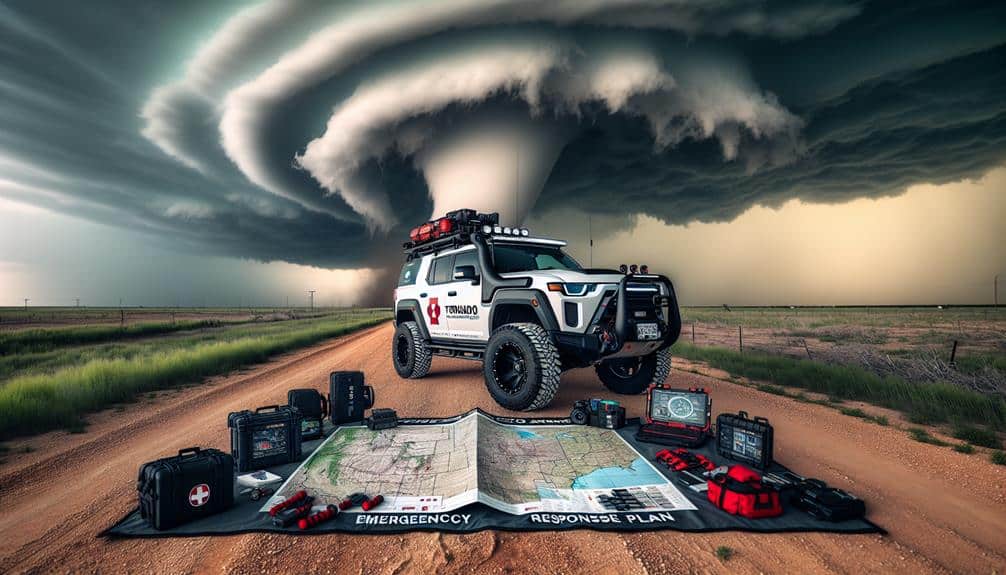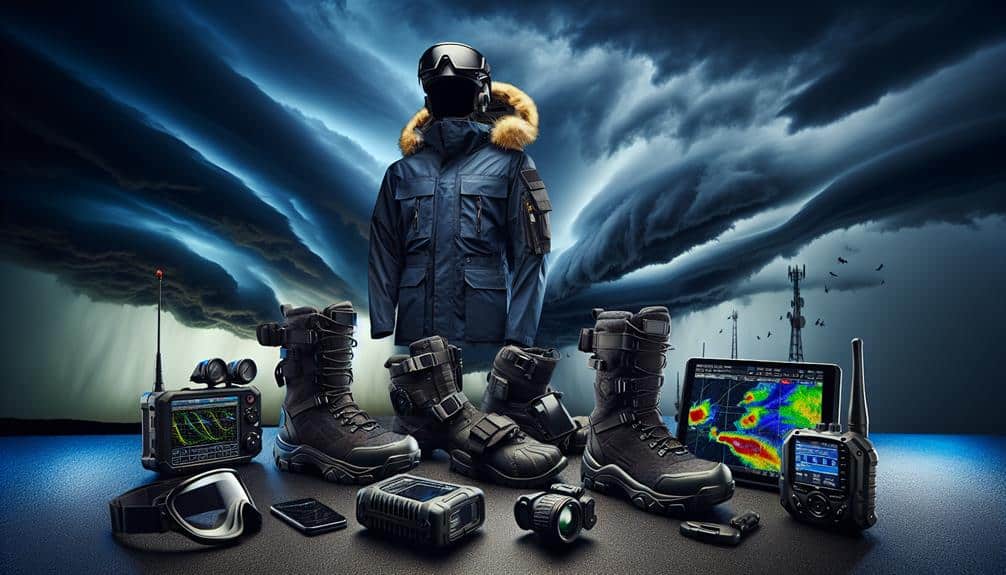We prioritize storm intercept safety by analyzing complex weather patterns and atmospheric dynamics. Our vehicles are equipped with high-definition radar systems and strengthened structures. We guarantee gear such as ANSI-certified helmets and Kevlar clothing meets top safety standards, while GPS tracking and redundant communication systems bolster team coordination. Rigorous equipment inspections and data analysis strengthen our predictive algorithms, and continuous improvement through post-intercept debriefs ensures our methods evolve. For those interested in the details of our thorough approach, detailed insights are ahead.
Key Points
- Utilize high-definition radar systems for real-time storm tracking and navigation to ensure safety during storm intercepts.
- Conduct thorough vehicle inspections to maintain critical components like tires and brakes in optimal condition for safe storm chasing.
- Wear ANSI-standard helmets and reinforced clothing to protect against debris and flying objects during severe weather conditions.
- Implement clear and concise communication protocols with GPS tracking and redundant systems to monitor and ensure team safety.
Understanding Weather Patterns
To effectively intercept and study storms, we must first analyze and understand the intricate weather patterns that drive their formation and behavior. We need to explore atmospheric dynamics, which are essential for predicting storm development. By examining cloud formations, we can identify the early stages of storm creation, as they reveal the underlying processes at work.
Our focus should be on wind patterns and pressure systems. Wind patterns, including jet streams and surface winds, influence the movement and intensity of storms. By mapping these patterns, we can predict where and how storms will travel. Pressure systems, such as high and low-pressure areas, play a pivotal role in storm formation. Low-pressure systems often lead to cloud formations and precipitation, while high-pressure systems can suppress storm activity.
Analyzing data from weather satellites, radar, and ground-based observations allows us to build a thorough picture of these dynamics. Understanding these elements gives us the freedom to make informed decisions during storm intercept missions.
Vehicle Preparation Essentials
Equipping our vehicle with high-definition radar systems and reinforced structures is essential for safely maneuvering through severe storm conditions. Cutting-edge radar systems offer real-time data on storm developments, enabling us to make informed decisions and navigate safely. Reinforced structures, such as roll cages and impact-resistant windows, enhance vehicle durability against debris and high winds.
A thorough vehicle inspection is non-negotiable. We must guarantee the integrity of all critical components—tires, brakes, and suspension systems, for instance. Tires should have sufficient tread depth and be properly inflated to maintain peak traction on wet or uneven surfaces. Brake systems need regular checks and maintenance to ensure they perform under pressure. Suspension systems must be sturdy enough to handle rough terrains without compromising vehicle control.
Emergency supplies are another cornerstone of our preparation. Stocking our vehicle with first aid kits, non-perishable food, water, and essential tools like flashlights and multi-tools prepares us for unforeseen circumstances. Communication devices, such as satellite phones and two-way radios, guarantee we remain connected even when traditional networks fail.
Essential Safety Gear
Beyond vehicle preparation, we must prioritize our personal protection by investing in essential safety gear designed to withstand severe storm conditions. Key items include helmets, reinforced clothing, and high-visibility vests. Helmets should meet ANSI standards, providing impact resistance essential for debris-laden winds.
Reinforced clothing, preferably with Kevlar, offers protection against flying objects and sharp debris. High-visibility vests guarantee we remain visible in low-visibility conditions, reducing the risk of accidents.
To guarantee our gear's reliability, stringent gear maintenance protocols are vital. Regular inspections for wear and tear must be scheduled, and any compromised equipment should be replaced immediately. For instance, helmet integrity can be compromised by minor cracks, necessitating replacement to maintain safety standards.
Safety protocols dictate that we not only use this gear but also understand its limitations. Training sessions on proper usage and emergency procedures enhance our preparedness. According to the National Weather Service, proper gear usage reduces injury risk by up to 60%, underscoring its importance.
Investing in high-quality gear and adhering to maintenance protocols isn't just about compliance; it's about ensuring our freedom to chase safely and effectively. Let's equip ourselves to face the storm's fury without compromising our safety.
Communication Strategies
Effective communication strategies are critical for coordinating our storm intercept efforts and guaranteeing team safety. We need a robust system that leverages both technology and human skills.
Radio etiquette is paramount; clear, concise, and professional communication minimizes misunderstandings and maximizes operational efficiency. Our safety protocols dictate specific language and procedures, guaranteeing everyone knows exactly what to do in any situation.
We should also implement GPS tracking to monitor the location of all team members in real-time. This allows us to make informed decisions about positioning and movement. Emergency signals, whether digital alerts or pre-agreed phrases, are essential for immediate action in critical moments.
To visualize our strategy, consider the following components:
- Two-way radios: Reliable communication devices with strict adherence to radio etiquette.
- GPS units: Trackers in each vehicle to provide constant location updates.
- Emergency signal protocols: Pre-defined signals for quick identification of urgent situations.
- Safety check-ins: Regular updates from all team members to confirm status and location.
Emergency Response Plans

Our emergency response plans need to be meticulously designed, integrating real-time data and predefined protocols to guarantee swift and effective action during critical situations. We prioritize setting up reliable systems for monitoring storm developments. By leveraging satellite data, radar readings, and on-the-ground reports, we can make informed decisions quickly.
Evacuation routes are a key component of our plans. We map out multiple egress options in advance, considering various storm scenarios. These routes are updated in real-time based on storm movement and local traffic conditions. This ensures that we've the flexibility to adapt our paths swiftly, maximizing safety and efficiency.
Emergency supplies are another cornerstone of our preparedness. Each vehicle in our convoy is equipped with inclusive kits that include first aid supplies, non-perishable food, water, and essential tools. Maintaining these supplies at optimal levels is non-negotiable; regular checks and updates are mandatory.
We also implement predefined communication protocols to coordinate with local emergency services and other chasers. This ensures that everyone is on the same page and can react promptly to any changes. Our goal is to mitigate risks while maintaining the flexibility to chase storms effectively.
Post-Intercept Procedures
After a storm intercept, we must prioritize systematic post-intercept procedures to guarantee operational efficiency.
We'll conduct a thorough equipment check and maintenance to uphold our readiness and safety standards.
Concurrently, our focus will be on a detailed data analysis summary and a structured team debrief session to optimize our future intercept strategies.
Equipment Check and Maintenance
Checking all equipment is meticulously examined and maintained post-intercept is vital for the accuracy and reliability of future storm data collection. After each intercept, we must prioritize a thorough equipment inspection and adhere to a strict maintenance schedule. This guarantees our gear is always in top condition, ready to capture essential data without fail.
We start by inspecting every piece of equipment for signs of wear and damage. This includes checking the integrity of sensors, verifying the calibration of instruments, and examining the physical condition of mounting hardware. It's important to identify any issues that might compromise data quality or operational safety.
- Inspect sensors for damage or misalignment: Confirm all sensors are intact and properly positioned.
- Calibrate instruments: Validate that all measurement devices provide accurate readings.
- Examine power supplies: Check batteries and power sources for wear and ensure they hold charge effectively.
- Review data storage devices: Verify memory cards and storage devices are functioning correctly and have sufficient capacity.
Data Analysis Summary
Once the equipment inspection and maintenance are complete, we immediately proceed to carefully analyze the collected storm data to extract meaningful insights.
Our first task involves cross-referencing real-time storm tracking data with radar and satellite imagery. This triangulation helps us validate the storm's trajectory and intensity, ensuring our initial assessments were accurate.
Next, we explore atmospheric pressure readings, wind speed measurements, and temperature gradients. These variables are vital for refining our risk assessment models. By analyzing these datasets, we can identify patterns that might predict future storm behaviors. Our goal is to enhance our predictive algorithms, making our next intercept safer and more efficient.
We also examine the data for anomalies, such as sudden shifts in wind direction or unexpected drops in barometric pressure. Identifying these outliers is crucial for understanding the storm's dynamics and potential hazards. This detailed analysis not only strengthens our storm tracking capabilities but also guides our safety protocols.
Team Debrief Session
In the immediate aftermath of the storm intercept, we convene a team debrief session to carefully review our field operations and gathered data. This critical step allows us to evaluate our performance and refine our approaches for future intercepts.
First, we examine strategies employed during the intercept, scrutinizing each decision and action to identify areas where we can enhance methods. This iterative process ensures continuous improvement of our methods.
Next, we scrutinize footage captured by our cameras and drones. High-definition video provides invaluable insights into storm behavior and our proximity to hazardous conditions. We then exchange findings to correlate visual data with our observations and sensor readings.
To foster a thorough debrief, we typically focus on:
- Logistics Review: Examining the efficiency of our travel routes and communication protocols.
- Equipment Performance: Evaluating the reliability and functionality of our instruments and vehicles.
- Safety Protocols: Reviewing adherence to safety measures and identifying any lapses.
- Data Integrity: Validating the accuracy and completeness of collected data.
This structured debrief session not only enhances our capabilities but also empowers us to operate with greater freedom and precision in future storm intercepts.
Frequently Asked Questions
How Can I Stay Updated on Changing Weather Conditions During a Storm Chase?
We stay updated on changing weather conditions during a storm chase by monitoring weather alerts, receiving updates via mobile apps, following safety precautions, and maintaining constant communication with our team. These steps guarantee our safety and efficiency.
What Are the Best Apps for Real-Time Storm Tracking?
We prefer storm radar apps like Radarscope and MyRadar for precise tracking. They provide real-time data and customizable weather alert notifications, ensuring we stay informed and can make swift, informed decisions during our storm chase adventures.
How Do I Find a Reliable Storm Chasing Partner or Group?
Finding a reliable storm-chasing partner is like finding a needle in a haystack. We should use online forums and local meetups to connect with experienced chasers, ensuring data-driven decisions and enhancing our freedom to explore safely.
What Should I Do if My Vehicle Gets Stuck During a Chase?
If our vehicle gets stuck during a chase, we should immediately initiate vehicle extraction using appropriate safety protocols. We must utilize emergency supplies and communication devices to guarantee safety and coordinate with rescue teams effectively.
Are There Any Legal Considerations or Permits Needed for Storm Chasing?
Remember how we always check our gear before a chase? Similarly, let's make sure we're aware of any permit requirements and legal considerations. Some areas need permits to chase; being prepared keeps our adventures hassle-free and lawful.


